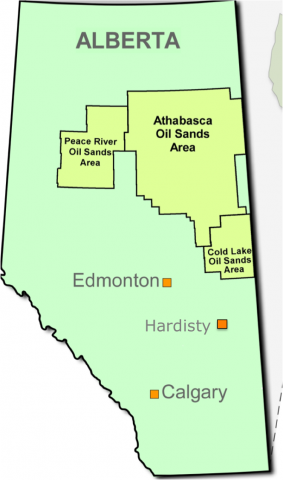Crude oil and diluent pipelines running through the two largest Canadian marketing and transportation hubs at Hardisty and Edmonton in Alberta have current capacity of 3.9 MMb/d. That will double to 8 MMb/d by 2018 if currently planned projects are completed. Getting the resultant expanding flows of crude and diluent in and out of Alberta via these hubs poses the same challenge that Gulf Coast operators are facing from the flood of crude descending on them from the US and Canada. Today we begin a new series detailing midstream Canadian terminal operations at Hardisty and Edmonton.
Previous Posts Around this Topic
This blog series primarily concerns Canadian crude oil storage close to production centers in Alberta. We have previously discussed the significance of crude storage in the US – in particular at Cushing, OK (see for example You’re Doin’ Fine Oklahoma, Bad Moon Rising and Rollin’ on the River of Crude). Whenever we talk about Canadian crude production we quickly get into quality and transportation issues associated with heavy crude bitumen that represents a significant and growing proportion of output (see Heat It Part 1 and Part 2). We have also written blog posts on the market for heavy Canadian crude at the US Gulf Coast (see The Gulf Coast Market for Heavy Canadian Crude). The storage hubs in Western Canada that we cover in this series are at the starting point for Canadian pipelines travelling east, west and south to the US. We have covered many of these pipelines in previous posts – especially looking at expansion and repurpose plans. We looked at projects to expand pipeline capacity to the West Coast of Canada (see West Coast Pipe Dreams Part 1 and Part 2) as well as new projects to move crude East (see What Becomes of the Empty Pipelines). Last but not least we have covered increased recent investment in terminals to load Canadian crude onto rail tank cars for transport to the US (see Alberta Rail Loading Terminals).
Growing Production
Western Canadian oil sands production is forecast by the Canadian Association of Petroleum Producers (CAPP, June 2013) to expand from 1.8 MMb/d in 2012 to 3.2 MMb/d in 2020 – an increase of 1.4 MMb/d. Over the same period conventional crude oil production in Western Canada will increase by 130 Mb/d from 1.25 MMb/d to 1.38 MMb/d. Local refineries process around 0.6 MMb/d of Western Canadian crude so the balance has either to be transported to Eastern Canada (where another 0.3 MMb/d is consumed) or to export markets. At the moment the vast majority of exports are sent by pipeline to the US. Controversy surrounding the building of new pipelines such as the Keystone XL to accommodate increased Canadian production has delayed pipeline projects and thrown the spotlight onto transport alternatives such as crude-by-rail. Whether travelling by pipeline or by rail, the crude needs to find a path to market.
Edmonton and Hardisty
For the majority of Western Canadian crude production, that journey to market involves passing through one or other (or both) of two critical marketing and transportation hubs in Alberta. These hubs are located in Edmonton, the provincial center of crude production and Hardisty – a tiny town that has become the pipeline crossroads of Western Canada. Because these two hubs are centers of transportation for crude oil leaving Alberta, they have also each developed significant crude storage capacity. Storage at Edmonton and Hardisty has expanded rapidly in recent years and is set to continue growing. The increased storage has primarily been in response to Canadian producers’ desire to store their crude in Western Canada whenever frequent congestion in the pipelines results in price discounting.
Source: Alberta Geological Survey (Click to Enlarge)
Hardisty and Edmonton are located about 112 miles apart. The map above shows the two hubs, the Canadian oil sands deposits and Calgary. The importance of these hubs to the crude oil industry is related to the major pipelines that either originate or pass through them. These pipelines serve two purposes. First they are the main gathering points for onward distribution to market of crude oil production from the oil sands region as well as conventional heavy and light oil production in Alberta. Second they are distribution hubs for incoming diluent supplies used in oil sands production and to dilute heavy bitumen oil so that it can flow in pipelines (see Heat It Part 1 for more on that process).
Join Backstage Pass to Read Full Article








